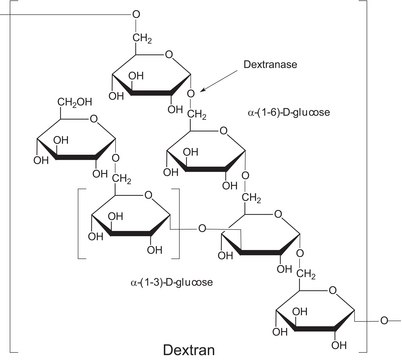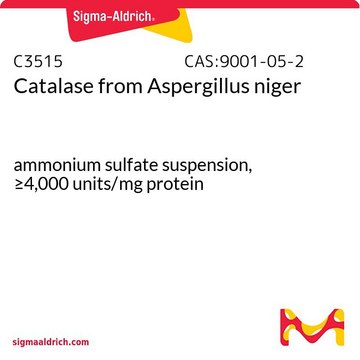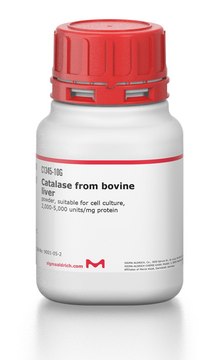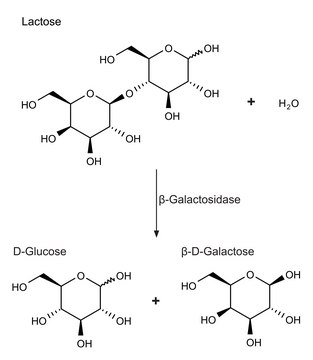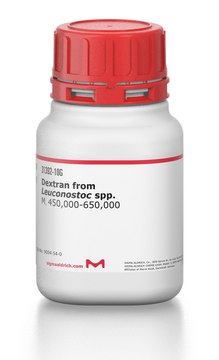D0443
Dextranase from Chaetomium erraticum
Synonym(s):
Dextranase Plus L, 1,6-α-D-Glucan 6-glucanohydrolase
Sign Into View Organizational & Contract Pricing
All Photos(1)
About This Item
Recommended Products
Related Categories
General description
A product of Novozymes Corp.
Dextranase is generated by many microorganisms, including bacteria, filamentous fungi, and yeast.
Application
Dextranase from Chaetomium erraticum has been used:
- in microcarrier dissolution to produce multicellular 3D spheroids for drug discovery
- in in vitro digestion of extracellular polysaccharide (EPS) from the bacterial isolates
- in a study to investigate the immobilization of dextranase
- to investigate the optimization of process conditions for enzymatic modification of alternan
Biochem/physiol Actions
Dextranase is an endodextranase that hydrolyzes α-(1,6)-glycosidic linkages in dextran. It has many industrial and clinical applications such as food processing, sugar modification, and medicine preparation. Dextranase is widely used to produce alternated sugar beet and isomaltooligosaccharides (IMOs), a prebiotic functional food. The low molecular weight dextran obtained from dextranase serves as a synthetic blood volume expander. Dextranase can be coupled to antibodies for the detection of tumor cells. It prevents the occurrence of dental plaques by depolymerizing microbial dextran deposits in teeth. Hence, it is used in dental care products.
Preparation Note
A fungal dextranase produced by submerged fermentation of Chaetomium erraticum.
Analysis Note
Stable in the pH range of 3-7 and at temperatures up to approx. 70 °C. For most applications, the preferred conditions are pH 5-6 and a temperature of 50-60 °C.
Other Notes
View more information on enzymes for complex carbohydrate analysis at www.sigma-aldrich.com/enzymeexplorer
Signal Word
Danger
Hazard Statements
Precautionary Statements
Hazard Classifications
Resp. Sens. 1
Storage Class Code
11 - Combustible Solids
WGK
WGK 1
Flash Point(F)
Not applicable
Flash Point(C)
Not applicable
Personal Protective Equipment
dust mask type N95 (US), Eyeshields, Gloves
Regulatory Information
常规特殊物品
Choose from one of the most recent versions:
Certificates of Analysis (COA)
Lot/Batch Number
Don't see the Right Version?
If you require a particular version, you can look up a specific certificate by the Lot or Batch number.
Already Own This Product?
Find documentation for the products that you have recently purchased in the Document Library.
F Abeille et al.
Lab on a chip, 14(18), 3510-3518 (2014-07-12)
Microfluidic bioreactors are expected to impact cell therapy and biopharmaceutical production due to their ability to control cellular microenvironments. This work presents a novel approach for continuous cell culture in a microfluidic system. Microcarriers (i.e., microbeads) are used as growth
Kinetics and thermodynamic of the purified dextranase from Chaetomium erraticum
Virgen-Ortiz JJ, et al.
Journal of Molecular Catalysis. B, Enzymatic, 122, 80-86 (2015)
Laura Montani et al.
Methods in molecular biology (Clifton, N.J.), 827, 305-317 (2011-12-07)
In contrast to typical Rho GTPases the regulation of atypical Rho GTPases, such as the members of the RhoBTB subfamily, rarely depends on GEFs and/or GAPs. Instead, they are regulated at the level of their expression, by post-translational modifications, by
Co-immobilization of dextransucrase and dextranase in epoxy-agarose-tailoring oligosaccharides synthesis
da Silva R, et al.
Process Biochemistry (Oxford, United Kingdom), 78, 71-81 (2019)
Frank Alwin Erhardt et al.
Journal of biotechnology, 131(4), 440-447 (2007-09-19)
In order to facilitate the Co-Immobilization of dextransucrase and dextranase, various techniques for the immobilization of industrial endo-dextranase from Chaetomium erraticum (Novozymes A/S) were researched. Adsorption isotherms at various pH-values have been determined for bentonite (Montmorillonite), hydroxyapatite and Streamline DEAE.
Articles
Uncover more about glycosaminoglycans and proteoglycans including the structure of glycosaminoglycans (GAGs), the different types of GAGs, and their functions.
Our team of scientists has experience in all areas of research including Life Science, Material Science, Chemical Synthesis, Chromatography, Analytical and many others.
Contact Technical Service

